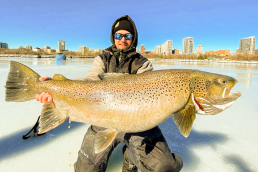The Big Picture in Ice Fishing
SHARE THIS POST
Sometimes, it’s good to look back and see how things have changed along the way. It helps you see the big picture and appreciate the importance of all the elements comprising the whole.
Over two generations, ice fishing has rapidly evolved from a crude, relatively hit-or-miss proposition into a highly efficient, high-tech pursuit of fish species through a canopy of ice. It now rivals the effectiveness of open-water angling if you take advantage of the available technology and apply the same sophistication, skills and determination as when fishing from a boat during spring, summer and fall.
Back in the day, frozen lakes appeared as vast, daunting waterscapes swept by blowing snow. Orientation atop the ice was iffy at best. Anglers used rifle-sight visualization incorporating landmarks along shore to mark known fishing spots to return to general areas where fish had been caught in the past. Or floundered around on foot, chiseling holes and testing the waters below by dropping weighted, baited lines to bottom. The whole process was slow, tedious and demanded a major commitment to achieve even meager results. And to make matters worse…it was cold!
Fast-forward to today, and ice fishing is a comparative cake walk. The journey began in the ‘80s when ice pioneer Dave Genz pioneered his “Trap Attack” system incorporating lightweight, portable Fish Trap sled/shelter combos, battery-powered depth finders, hand or gas augers, short ice rods, a handful of lures and baits, and minimal support gear to probe offshore areas.
Nowadays, anglers still apply the same fundamental system, blessed by technologies that early ice anglers could only dream of: Head-to-toe insulated clothing; efficient support gear; ATV/snowmobile/SUV/truck transport; deluxe, insulated, portable and towable shelters; and incredible electronics revealing the wonders and mysteries of the underwater world, quickly and in vivid detail. A decade or so ago, noted ice guide Tony Roach nicknamed the modern fish-locating process Ice Trolling due to the speed at which anglers could probe new areas, determine productive spots and patterns, and trigger bites or strikes from the fish below.
As good as things had become by then, they have quantum leapt forward the past few seasons with the explosion of live viewing electronics used below the ice. Where ice anglers once relied on traditional open-water sonar units adapted for use through the ice, they now have 360-degree viewing at a distance below their holes. What’s more, it provides detailed views of fish size, and clues toward probable species, in any direction, at long distances, from the hole. And it works day or night, in clear or dingy waters, far outpacing the still very useful but more limited functionality of underwater cameras which are subject to shorter-range viewing directly beneath your hole.
Are you enjoying this post?
You can be among the first to get the latest info on where to go, what to use and how to use it!
Even given all the modern wonders at your disposal, you still must actually catch the fish! You still have to figure out where and how deep they are; if they’re relating to cover, structure or open water; if they’re moving or stationary; the times of day they’re most likely to feed; the types of lures, baits or presentations they’re most likely to bite or strike; how to tempt or tease them into biting or striking when they’re reluctant to do so; and whether you need to apply finesse or aggressive techniques.
And the part that newcomers who are long on technology but short on experience tend to downplay: You need to understand what each species of fish requires, and has available to them to satisfy those needs, beneath the ice; where they are likely to be under the ice due to changing forage type and location; where they will likely migrate to, from first-ice feeding locales, to midwinter areas to late-ice destinations near shallow, spring feeding and spawning grounds; and along the way, in changing weather and seasonal conditions, just what it might take to catch them.
In the end, technology may have made the search more effective, efficient and comfortable—but old school knowledge of what makes fish tick beneath the ice never goes out of style. You still need a thorough understanding of how the underwater world works! You must go out and earn it over time, with effort, backed by an eagerness to learn.
For helpful ice fishing insight, check out the articles in the winter issues of MidWest Outdoors. Subscribe on our website.
Did you enjoy this post?
You can be among the first to get the latest info on where to go, what to use and how to use it!
Dave Csanda
Dave Csanda has enjoyed 40 years in the fishing communications industry at In-Fisherman, Angling Edge and now, as editor of MidWest Outdoors. He is an inductee of both the Minnesota and National Fresh Water Fishing Halls of Fame.

